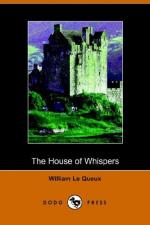In the twelfth century the aspect of the deep glen was very different from what it is to-day. In those days the Ruthven was a broad river, flowing swiftly down to the Earn, and forming, by reason of a moat, an effective barrier against attack. To-day, however, the river has diminished into a mere burn meandering through a beautiful wooded glen three hundred feet below, a glen the charms of which are well known throughout the whole of Scotland, and where in summer tourists from England endeavour to explore, but are warned back by Stewart, Sir Henry’s Highland keeper.
A quarter of a mile from the great historic ruin is the modern castle, built mainly of stone from the ancient structure early in the eighteenth century, with oak-panelled rooms, many quaint gables, stained glass, and long, echoing corridors—a residence well adapted for entertaining on a lavish scale, the front overlooking the beautiful glen, and the back with level lawns and stretch of undulating park, well wooded and full of picturesque beauty.
The family traditions and history of the old place and its owners had induced Sir Henry Heyburn, himself a Fellow of the Society of Antiquaries, to purchase it from Lord Strathavon, into whose possession it had passed some forty years previously.
History showed that William de Graeme or Graham, who settled in Scotland in the twelfth century, became Lord of Glencardine, and the great castle was built by his son. They were indeed a noble race, as their biographer has explained. Ever fearless in their country’s cause, they sneered at the mandates from impregnable Stirling, and were loyal in every generation.
Glencardine was a stronghold feared by all the surrounding nobles, and its men were full of valour and bravery. One story of them is perhaps worth the telling. In the year 1490 the all-powerful Abbot of Inchaffray issued an order for the collection of the teinds of the Killearns’ lands possessed by the Grahams of Glencardine in the parish of Monzievaird, of which he was titular. The order was rigorously executed, the teinds being exacted by force.
Lord Killearn of Dunning Castle was from home at the time; but in his absence his eldest son, William, Master of Dunning, called out a number of his clansmen, and marched towards Glencardine for the purpose of putting a stop to the abbot’s proceedings. The Grahams of Glencardine, having been apprised of their neighbour’s intention, mustered in strong force, and marched to meet him. The opposing forces encountered each other at the north side of Knock Mary, about two miles to the south-west of Crieff, while a number of the clan M’Robbie, who lived beside the Loch of Balloch, marched up the south side of the hill, halting at the top to watch the progress of the combat. The fight began with great fury on both sides. The Glencardine men, however, began to get the upper hand and drive their opponents back, when the M’Robbies rushed down the hill to the




